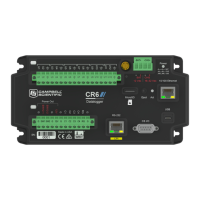5.3 SRAM
SRAM holds program variables, communications buffers, final-data memory, and, if allocated,
the USR drive. An internal lithium battery retains this memory when primary power is removed.
The structure of the data logger SRAMmemory is as follows:
l Static Memory: This is memory used by the operating system, regardless of the running
program. This sector is rebuilt at power-up, program recompile, and watchdog events.
l Operating Settings and Properties: Also known as the "Keep" memory, this memory is used
to store settings such as PakBus address, station name, beacon intervals, and allowed
neighbor lists. This memory also stores dynamic properties such as known routes and
communications timeouts.
l CRBasic Program Operating Memory: This memory stores the currently compiled and
running user program. This sector is rebuilt on power-up, recompile, and watchdog events.
l Variables & Constants: This memory stores constants and public variables used by the
CRBasic program. Variables may persist through power-up, recompile, and watchdog
events if the PreserveVariables instruction is in the running program.
l Final-Data Memory: This memory stores data. Auto-allocated tables fill whatever memory
remains after all other demands are satisfied. A compile error occurs if insufficient memory
is available for user-allocated data tables. This memory is given lowest priority in SRAM
memory allocation.
l Communication Memory 1: Memory used for construction and temporary storage of
PakBus packets.
l Communication Memory 2: Memory used to store the list of known nodes and routes to
nodes. Routers use more memory than leaf nodes because routes store information about
other routers in the network. You can increase the Communication Allocation field in
Device Configuration Utility to increase this memory allocation.
5. Data memory 59

